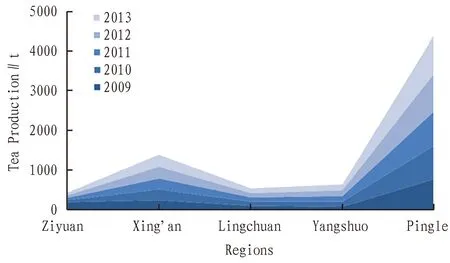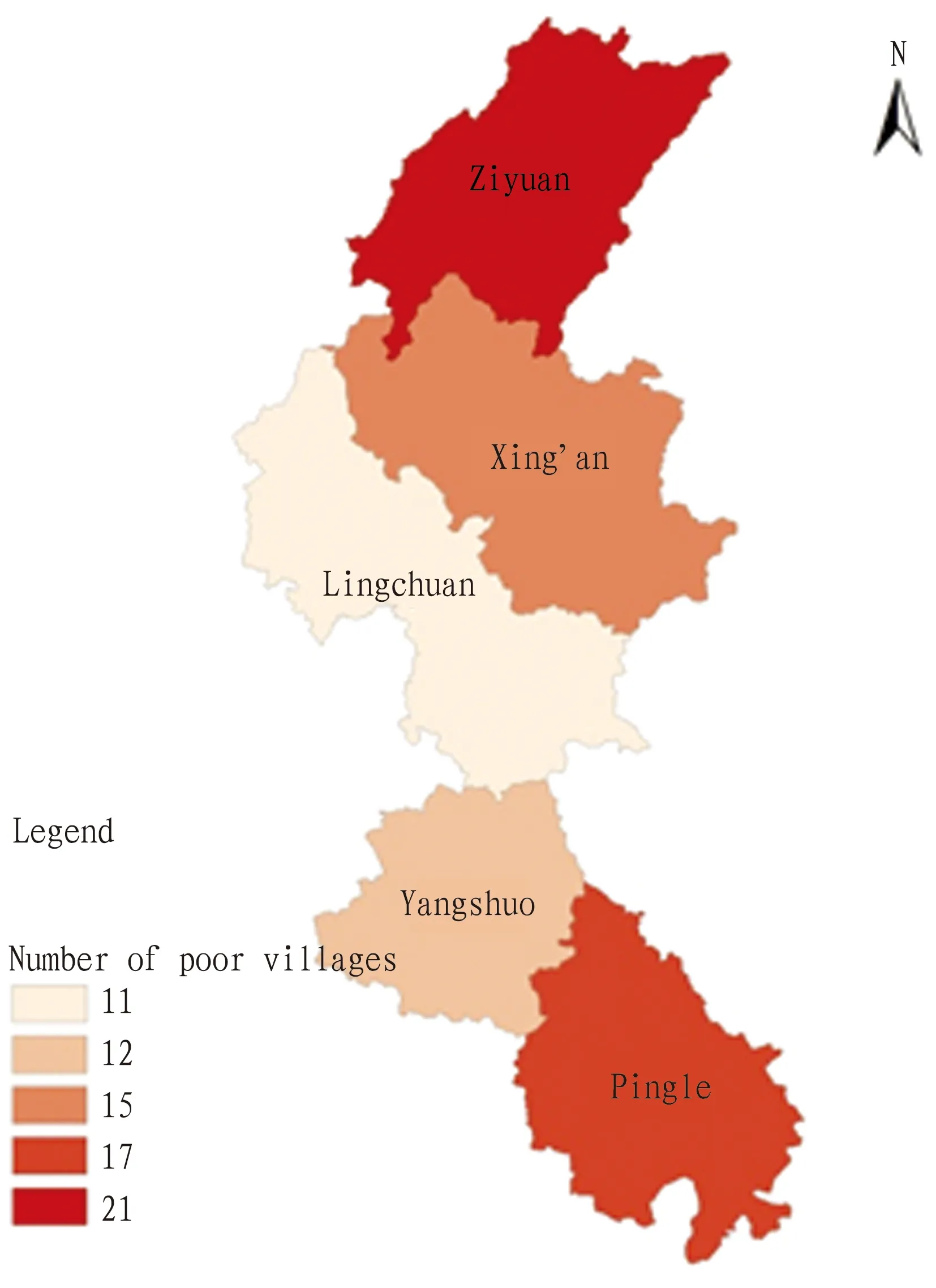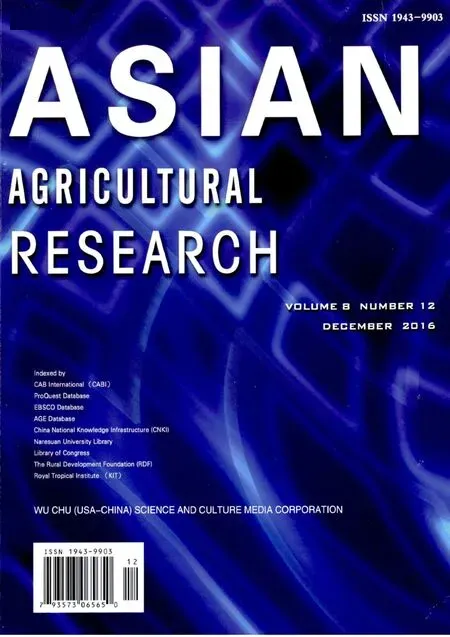How to Improve Tea Farmers’ Livelihoods in the Sightseeing Place along Lijiang River Valley?
,
Business School, Guangxi University, Nanning 530004, China
1 Introduction
With the sustained and rapid development of China’s tourism industry, the non-equilibrium characteristics of regional tourism economic development are becoming increasingly significant[1]. How to alleviate poverty for the poor people in the sightseeing place has started to receive wide attention[2]. In academic research, the thought about the poor people’s livelihoods originated from Robert Chambers’ writings in the mid-1980s[3]. In the late 1980s, the report of the World Commission on Environment and Development used the concept of sustainable livelihoods aimed at eliminating human poverty. Since then, this concept has been continuously deepened and extended, stressing that people’s economic life has the ability to withstand external shock and can be quickly restored after shock. In recent years, the foreign researchers or organizations have developed several analytical frameworks of livelihoods, and the SLA framework proposed by UK Department for International Development (DFID) has the widest influence[4]. The framework places farmers in a fragile environment, and decomposes farmers’ resources into human capital, natural capital, financial capital, physical capital and social capital. This framework offers a guide for people to understand and solve the problem of poverty. Guilin Lijiang River is one of China’s earliest national scenic areas. Behind the flourishing tourism industry lies about 76 poor villages in 5 counties along Lijiang River (2012). Sightseeing place, as a complex system, carries a variety of stakeholders and industrial factors[5]. In fact, Lijiang River Valley is not only Guangxi’s traditional sightseeing place, but also one of the best areas suitable for cultivation of tea in Guangxi. Based on the tea industry along Lijiang River Valley, this paper introduces the basic framework of sustainable livelihoods, and makes a comprehensive analysis of tea farmers’ living conditions in the valley, with a view to providing a reference for the tea farmers in the sightseeing place to improve their livelihoods and get rid of poverty accurately.
2 The tea industry in the sightseeing place along Lijiang River Valley
Lijiang River Valley is in Guilin City of the northeast of Guangxi, and it features a humid subtropical climate, with abundant rainfall, adequate light and fertile soil. The forest coverage rate reaches 67%. The unique weather conditions for the growth of tea have dotted the mountains along Lijiang River Valley with high quality wild tea. The main tea products include Fuding Dahao, Fuding Dabai, Fuding 6, Taicha, Guilu 1, Lingui Wantianzhong, Longjizhong, Ziyuan Dayezhong, as well as a small amount of Longjing, Anji white tea and Wuniuzao[6]. From 2009, the average annual growth rate of tea production in Guilin City along Lijiang River Valley was 3%, and the tea production reached 2808 t in 2013 (see Fig. 1). In the 5 tea planting counties, Pingle County in the lower reaches of Lijiang River has the highest five-year cumulative tea production, and its tea production accounts for 59% of total tea production along Lijiang River Valley (see Fig. 2).

Data source:GuilinEconomicandSocialStatisticsYearbook(2010-2014).
Fig.1Teaproductiontrendsin5countiesofGuilinCityalongLijiangRiverValleyduring2009-2013

Fig.2TotalteaproductioninGuilinCityalongLijiangRiverValleyoverthepastfiveyears(unit:t)
3 Problems
3.1WeakeconomicfoundationandscarcelivelihoodcapitalLijiang River Valley has good weather conditions for tea planting, and the related livelihood capital is still weak for local farmers. In terms of financial capital, the farmers in the counties along Lijiang River Valley are not rich enough, and each county has at least 10 villages in the poverty line. The overall distribution of poor villages can be shown in Fig. 3, and there is a certain weak coupling relationship between the distribution and weak industrial penetrability of tourism. In terms of human capital, the available high-quality labor resources are scarce for the development of tea industry. In 2013, Pingle County had the largest number (236800) of labor resources along Lijiang River Valley, while Ziyuan County had the smallest number (91100) of labor resources. Because of the low economic returns of the tea industry, most of the young labor resources choose to plant other cash crops or work outside the hometown. The elderly, women and children are generally left behind in rural areas.
3.2LackofbargainingpowerandlowmarketriskresistancecapacityThe tea farmers along Lijiang River Valley are in the lowest end of industrial chain, and they can only passively accept market price volatility, which directly affects the basic income and planting enthusiasm of tea farmers. For a long time, under the impact of the well-known tea brands in China, there have been some increasingly prominent problems in tea products along Lijiang River Valley such as low popularity and lack of core brands. Local tea farmers can only sell the tea to brokers or processors at low prices according to local market conditions. Based on survey, it is found that the purchase price of tea along Lijiang River Valley is 25 to 50 yuan per kg. This is in contrast to the rising labor costs of planting and harvesting. The per capita income of some tea farmers is only about 2000 yuan, weakening farmers’ enthusiasm for planting.

Data source: Guangxi Poverty Alleviation Office (as of 2012).
Fig.3ThedistributionofpoorcountiesinGuilinCityalongLijiangRiverValley
3.3PestanddiseaserisksandrisingcostsofresistingrisksThe costs of tea farmers dealing with various pests and diseases along Lijiang River Valley is rising, affecting the livelihood and income of tea farmers. The spring season in Lijiang River Valley is usually in late February to early May, and the main risks are pests as well as tea bud blight and tea white scab in the mountainous tea area. The summer tea season is in mid-May to early August, pests and diseases are frequent in this season, and tea grey blight, tea brown blight and tea anthracnose are especially prevented. The autumn tea season is generally in mid-September to October, and this season focuses on preventing tea caterpillar, tea looper, tea tarsal line mites and other pests[7]. It can be seen that the increase of the cost leads to uncertainty in tea farmers’ livelihood level in the whole year.
4 Conclusions and recommendations
4.1ConclusionsThe livelihoods of the tea farmers in sightseeing place along Lijiang River Valley still face many challenges, but owing to fine tea planting environment and favorable conditions of tourism, the farmers can choose flexible livelihood combination strategy and diversified improvement path to make their livelihoods more sustainable and ultimately alleviate poverty. However, the comprehensive analysis of issues concerning tea farmers’ livelihoods along Lijiang River Valley can not replace the sampling and evaluation of individual tea farmers. In the framework of sustainable livelihoods, the further sampling survey of livelihood capital will be the basic direction of in-depth analysis of tea farmers’ livelihoods.
4.2Recommendations
4.2.1Actively playing the leading role of government and enterprises. In the case of limited capacity of tea farmers along Lijiang River Valley, the government should increase policy support and poverty alleviation support, guide enterprises to cooperate with farmers in a variety of ways, and carry out the cultivation and processing of tea products. Enterprises are the main market players, and tea processing enterprises are the key link in the transformation from tea raw materials to tea products. In order to speed up the pace of accurate poverty alleviation, the government should actively promote and speed up the development of local tea industry, construct demonstration tea farm and tea factory with high standards, and attract investment to set up tea enterprises. By taking the "company + farmer" approach, the enterprises are responsible for purchasing seedlings, tea farmers are responsible for cultivation management, and it is acquired based on the contract price, so as to improve tea farmers’ enthusiasm, reduce risk, and increase predictability and sustainability of livelihoods.
4.2.2Using new media and innovating upon tea product marketing model. In order to enhance the direct income of tea farmers, farmers can expand sale channels, innovate upon marketing model, and explore new media marketing. The new media marketing tools suitable for tea farmers in the sightseeing place include network community marketing, microblogging marketing, and WeChat marketing. Among them, inviting the relevant community experts to take part in picking tea, making tea, tasting tea and appreciating tea, and transforming the experience into travel notes with excellent pictures and texts, is a network community marketing method for tea farmers. At the same time, the microblogging and WeChat platform can be used to send messages about tea products, tea leisure and tea entertainment in different seasons to consumers, in order to have timely access to consumer feedback and achieve interaction with the target consumers. The use of new media is expected to break the limitations of traditional communication channels, so that the scattered tea farmers have the opportunity to face the consumers, increase sale opportunities and improve the livelihood level.
4.2.3Enhancing brand awareness and increasing high-end tea brand recognition. It is necessary to strengthen building tea brands along Lijiang River Valley, enhance the influence of high-end tea, and improve the livelihood of tea farmers. In face of fierce competition from many well-known tea brands, it is necessary to establish tea brands and produce high end tea product in order to make local products stand out. Firstly, it is necessary to further increase efforts to promote the declaration of GI tea products with regional characteristics, and use a variety of traditional fairs, trade fairs and modern network to establish tea brand. Secondly, it is necessary to carefully build the rare wild tea brand to go into the high-end market. Through the establishment of regional brands and high-end brands, it can enhance local tea farmers’ self-confidence and effectively improve the livelihood of tea farmers.
4.2.4Creating industrial convergence-oriented rural tourist zone with tourism function. In the tea cultivation areas where conditions permit, using tea mountain landscape advantages to promote industrial convergence, create thematic rural tourist areas and divert tourist sources, is an effective way to enrich the livelihood combination and widen the source of income for tea farmers. Firstly, it is necessary to pay attention to the uniqueness design and building of core attractions, and focus on the tea garden landscape element integration and construction to form the integration of regional landscaping and leisure function. Secondly, it is necessary to strengthen the configuration of tourism elements and improve food, housing, travel, shopping, entertainment and other elements. It is necessary to build the supporting facilities suitable for carrying out some tourism activities catering to modern consumer habits and taste such as tea picking, tea ceremony performance and tea garden camping, so that the consumers fully appreciate the charm of regional tea culture. Thirdly, it is necessary to strengthen the management and establish a sound management system and a fair distribution mechanism. A variety of ways should be used to make tea farmers participate in the operation and combine tea production with employment about tourism services, so that tea farmers can obtain greater returns from tea production and diversification operation.
[1] JIANG LQ. The research on strategy and tactics of the inclusive growth in the region with imbalance developed tourism economy take the Pan Yangtze River Delta tourism area as example[J]. Economic Geography, 2012(6):167-172. (in Chinese).
[2] FENG CF. Study on the strategy of sustainable tourism development in poor tourist destination[J]. Territory & Natural Resources Study, 2005(1): 67-68. (in Chinese).
[3] LI F. Sustainable livelihoods:Theory, method and application[M]. Beijing: China Social Sciences Press, 2015: 1-2. (in Chinese).
[4] TANG Q. Research progress and future key trends of sustainable livelihoods[J]. Advance in Earth Sciences, 2015(7): 823-833. (in Chinese).
[5] GUO W, FANG SF. The study of developing and functioning synergic mechanism of tourist destination composite system[J]. China Soft Science, 2003(7): 147-152. (in Chinese).
[6] QIN CL, WEI JF, PANG YL. The current situation and cpuntermeasures of the development of tea industry in Guilin[J]. Guangxi Horticulture, 2014(4): 23-25. (in Chinese).
[7] LUO YX, LIN CC, ZHUGE TQ. Occurrence and integrated control technique of pest and disease on teas in Gulin tea-producing areas[J]. Journal of Guangxi Agriculture, 2010(4): 55-58. (in Chinese).
 Asian Agricultural Research2016年12期
Asian Agricultural Research2016年12期
- Asian Agricultural Research的其它文章
- Brand Construction of Agricultural Enterprises: A Case Study of Hubei Hanway Ecological Agriculture Group
- Impact of Online Comments on Purchase Intention of College Student Consumers under Online Shopping
- Empirical Research on Farmer’s Breaching Behavior in Order Contract
- Suitability Evaluation of Garden Landscape in Chizhou Residential Area
- Effect of Vector Density and Competence on Macromolecular Vector Transformation Efficiency
- Evaluation on the Level of Agricultural Informatization Development in Gansu Province during 2001-2010
